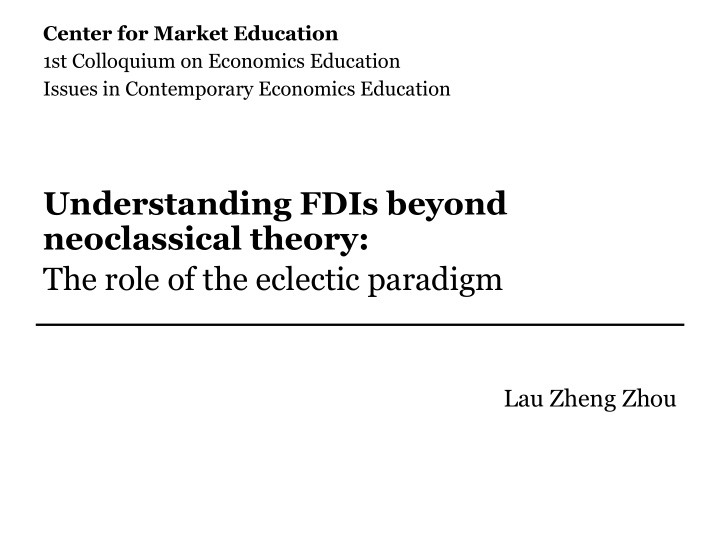



Center for Market Education 1st Colloquium on Economics Education Issues in Contemporary Economics Education Understanding FDIs beyond neoclassical theory: The role of the eclectic paradigm Lau Zheng Zhou
Background 1. Development of theoretical models for FDI began in the 1960s, just when FDI flows started to arise (Jones and Wren, 2006; Almahmood, 2010). 2. There was no underlying theoretical model and FDI was explained based on trade theories. 3. But the rise of FDI flows in the post-world war two period has prompted researchers to develop a comprehensive theoretical model for FDI. 4. This paper discusses Dunning’s eclectic paradigm which has been widely viewed as the most comprehensive theory on FDI to assess evolving investment motivations and to consider its relevance given the rising complexity and fragmentation in global production today. 2
Ricardian theory of Comparative Advantage In traditional neoclassical theory, the firm is a ‘black box’, and no FDI is possible. All firms have equal access to the same resources and capabilities within their own countries, while there is complete immobility of resources and capabilities between countries Static • • Industry-neutral • Operate in vacuum • Fragmentation of global production 3
Fragmentation of global production 4
Dunning’s eclectic paradigm 1. The eclectic (or OLI) paradigm has remained the dominant analytical framework for an operationally testable determinants of FDI. 2. MNEs undertake FDI to augment comparative advantage. 3. Ownership (O) : More likely to engage in FDI if competitive advantage is greater relative to those of other firms 4. Locational (L) : Favour foreign presence if resources are immobile, naturally-endowed and help to augment Ownership advantage 5. Internalization (I) : Favour FDI if there is net benefit to internalizing cross-border intermediate product markets rather than licensing the right or franchising 5
Dunning’s four classic motives of FDI (1980, 1993, 2000) As countries have liberalized and the rules of global competition has changed, so have the motivations in entering foreign markets. 1. During the post-WWII period, geo-political 4. Since the 1970s, conditions were relatively regulated. rapidly rising 2. MNEs investment abroad was mostly production costs at Market- conducted for market-seeking motives. home prompted seeking 3. MNEs established production in the markets resource-seeking & they wished to serve, and almost all stages of efficiency-seeking production were carried out in the same motives. country. 5. Focusing on relocating Resource- Seeking to developing countries 7. By the 1990s, fragmentation of production to take advantage of & favours integration of immediate goods lower cost and Efficiency- production, final assembly and support favourable policies. seeking services within a region – coordinated by 6. The rise of HQs regional HQs. coordinating global 8. Strategic asset-seeking motives became activities in a modular Strategic more prominent to acquire foreign assets as fashion due to cost Asset- to gain access to technology, resources and considerations. seeking new markets. 9. This is followed by a period of consolidation of integrated production via offshoring & outsourcing. 6
Mind the Gap Despite its popularity, Dunning’s classic framework faces many criticisms especially when dealing with Emerging Multinational Enterprises (EMNEs) 1. To understand upgrading at the firm-level along the value chain - Rising trends of fragmentation and integration of global production activities may mean that MNEs have multiple or all of the motives of FDI simultaneously, rendering Dunning’s classic framework less effective. - Also, existing literature mostly analyzes upgrading processes at the industry level , i.e. shifting from lower added-value to higher added-value sectors (Gereffi, 1999; Humphrey & Schmitz, 2002). 2. Assuming an all- powerful global “lead firm” and largely ignore the institutional context. - There is an evolutionary context to how local firms become EMNEs. - EMNEs may have weaker positions compared to MNEs from developed countries. EMNEs often face higher home- and host-country institutional constraints , especially in the case of Chinese MNEs (Luo and Tung, 2007; Deng, 2011; Cuervo- Cazurra & Narula, 2015; Prananond, 2015). 7
Typology of GVC governance (Gereffi, Humphrey, and Sturgeon, 2005) Source: Drawing is taken from Inomata, S. (2017) 8
An example of a value chain (The Philippines in the automotive GVC) Source: Sturgeon et al., (2016) 9
Policy Implications Potential implications for policy makers: 1. To link industrial upgrading to participation in GVCs. Policymakers should identify and target segments of value chains which our local firms have comparative advantage, and not to attract the entire value chain. • Perhaps targeting electronic component for electric vehicles with upgrading potential in e-battery, rather than the entire value chain. 2. To enhance policy clarity and signal in the types of FDI to attract and approve, bearing the nature of FDI motivation and GVCs in mind. 3. To encourage promotion of industrial development on a longer-term trajectory by addressing domestic institutional bottlenecks 10
Thank You 11
Recommend
More recommend